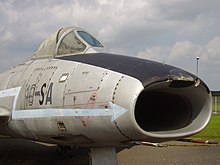
An intake (also inlet) is an opening, structure or system through which a fluid is admitted to a space or machine as a consequence of a pressure differential between the outside and the inside. The pressure difference may be generated on the inside by a mechanism, or on the outside by ram pressure or hydrostatic pressure. Flow rate through the intake depends on pressure difference, fluid properties, and intake geometry.
Intake refers to an opening, or area, together with its defining edge profile which has an associated entry loss, that captures pipe flow from a reservoir or storage tank.[1] Intake refers to the capture area definition and attached ducting to an aircraft gas turbine engine[2] or ramjet engine and, as such, an intake is followed by a compressor or combustion chamber. It may instead be referred to as a diffuser.[3] For an automobile engine the components through which the air flows to the engine cylinders, are collectively known as an intake system[4] and may include the inlet port and valve.[5] An intake for a hydroelectric power plant is the capture area in a reservoir which feeds a pressure pipe, or penstock, or into an open canal.[6]
- ^ Massey, Bernard Stanford (1979). Mechanics Of Fluids (4th ed.). Van Nostrand Reinhold. p. 201. ISBN 0-442-30245-2.
- ^ Seddon, J.; Goldsmith, E.L. (1999). Intake Aerodynamics (2nd ed.). Blackwell Science. ISBN 0-632-04963-4.
- ^ Bader, F.; Bunt, E.A. (February 1960). Ramjet Technology Thermodynamics Of Ramjet Flow Processes. Silver Spring, Maryland, US: Johns Hopkins University, Applied Physics Laboratory. p. 75. Document TG 370-2.
- ^ Knowles, Don; Erjavec, Jack (1998). Automotive Engine Performance (2nd ed.). US: Today's Technician. p. 200. ISBN 9780827385191.
- ^ Heywood, John B. (1988). Internal Combustion Engine Fundamentals. McGraw-Hill Education. p. 54. ISBN 0-07-028637-X.
- ^ Muller, Richard (1921). Hydroelectrical Engineering. New York: G. E. Stechert & Co. p. 142.